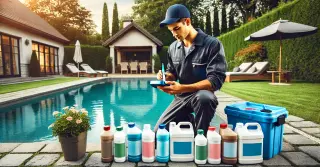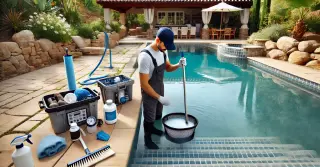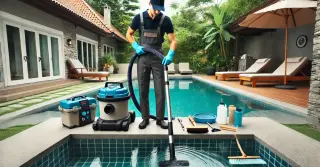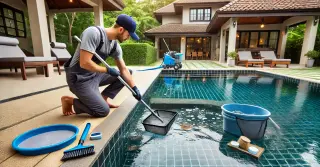Pool Chemical Balance Franklin MI

Keeping your pool's chemical balance in check is crucial for a safe and healthy swimming environment. Correct chemical levels stop algae and bacteria growth, ensure clear water and protect pool surfaces and equipment.
- Balancing pH Levels: Your pool's pH level reflects its acidity or alkalinity. A balanced pH level should be between 7.2 and 7.6. If the pH is too low, the water becomes acidic, which can cause skin irritation and corrosion of pool equipment. If the pH is too high, the water becomes alkaline, leading to cloudy water and scaling on the pool surfaces. Consistently testing and adjusting pH levels is vital for swimmer comfort and safety.
- Monitoring Chlorine Levels: Chlorine plays a crucial role in pool sanitation, destroying bacteria, algae, and other harmful pathogens. The ideal chlorine level should be between 1-3 ppm (parts per million). Too little chlorine can lead to unsanitary conditions, allowing bacteria and algae to thrive. Excessive chlorine leads to skin and eye irritation and produce a strong chlorine odor. Consistently monitoring and adjusting chlorine levels ensures effective sanitation and swimmer comfort.
Balancing AlkalinityTotal alkalinity is another critical aspect of pool water chemistry. Alkalinity acts as a buffer for pH levels, helping to prevent drastic changes in pH. The optimal total alkalinity range is 80-120 ppm.
- Avoiding pH Fluctuations: Proper alkalinity levels help stabilize pH levels, preventing rapid pH shifts that cause skin irritation and surface damage. Low alkalinity results in unstable pH levels, making consistent balance difficult. High alkalinity causes cloudy water and scaling. Regularly testing and adjusting alkalinity levels is essential for maintaining a stable and balanced pool.
- Calcium Hardness Control: Calcium hardness indicates the calcium level in pool water. Optimal calcium hardness levels are between 200-400 ppm. Low calcium levels result in corrosive water, harming surfaces and equipment. If calcium levels are too high, it can cause scaling on pool surfaces and cloud the water. Frequent calcium hardness testing and adjustments is crucial for safeguarding your pool and maintaining clear water.
Using Pool Chemicals SafelyProper handling and storage of pool chemicals is essential for both safety and effectiveness. Store chemicals in a cool, dry place, away from sunlight, children, and pets. Always follow the manufacturer's instructions for dosing and application.
- Proper Chemical Measurement and Mixing: Measuring pool chemicals accurately is essential to maintain the proper balance. Using incorrect amounts can imbalance chemicals and harm water quality. Always use a clean, dry measuring cup or scoop and avoid mixing chemicals directly. Mix in water as needed, following guidelines carefully.
- Chemical Reaction Awareness: Some pool chemicals can react dangerously when mixed. For instance, never mix chlorine and acid. Understanding these interactions prevents accidents and ensures safe handling. Keep chemicals separate and handle with caution to avoid harmful reactions.
Maintaining the proper chemical balance in your pool is vital for a safe, clean, and pleasant swimming experience. By frequently testing and balancing pH, chlorine, alkalinity, and calcium, you ensure optimal water quality.
Safe handling and storage of pool chemicals further ensure the health and safety of your pool and its users.




